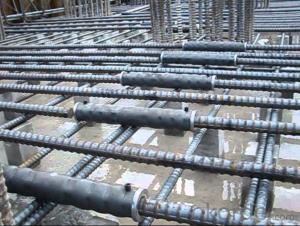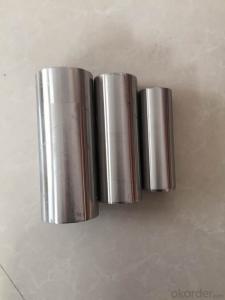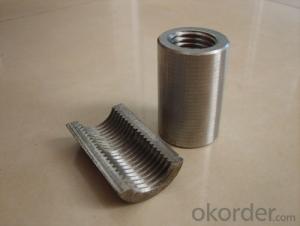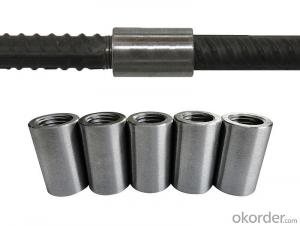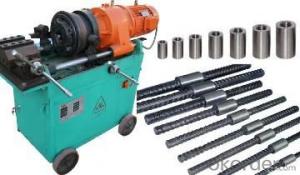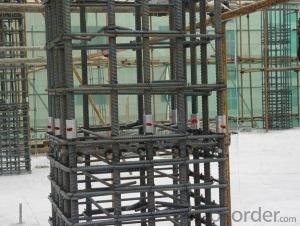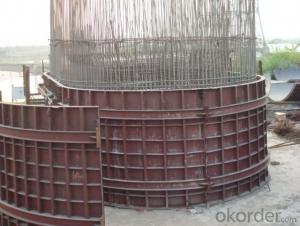Steel Coupler Rebar Scaffolding Truss Aluminum Scaffolding Beam Low Price
- Loading Port:
- Shanghai
- Payment Terms:
- TT OR LC
- Min Order Qty:
- 10000 pc
- Supply Capability:
- 10000000 pc/month
OKorder Service Pledge
OKorder Financial Service
You Might Also Like
Steel Coupler Rebar Scaffolding Truss Aluminum Scaffolding Beam with Low Price
1.Description:
Lapped joints are not always an appropriate means of connecting rebar. The use of Steel Rebar Couplers can simplify the design and construction of reinforced concrete and reduce the amount of reinforcement required.
The threaded steel coupler system is designed as a threaded reinforcement connection with 100% load transmission. The steel coupler rebar connection system is suitable for both static and dynamic load transmission in construction joints.
The coupler is designed as a threaded reinforcement connection for formed construction joints. Reinforcement work is normally carried out on both sides of the construction joint using lap joints or one side is anchored. The bar lengths are based on the structural analysis requirements of the building component and are calculated from anchorage and lap lengths.
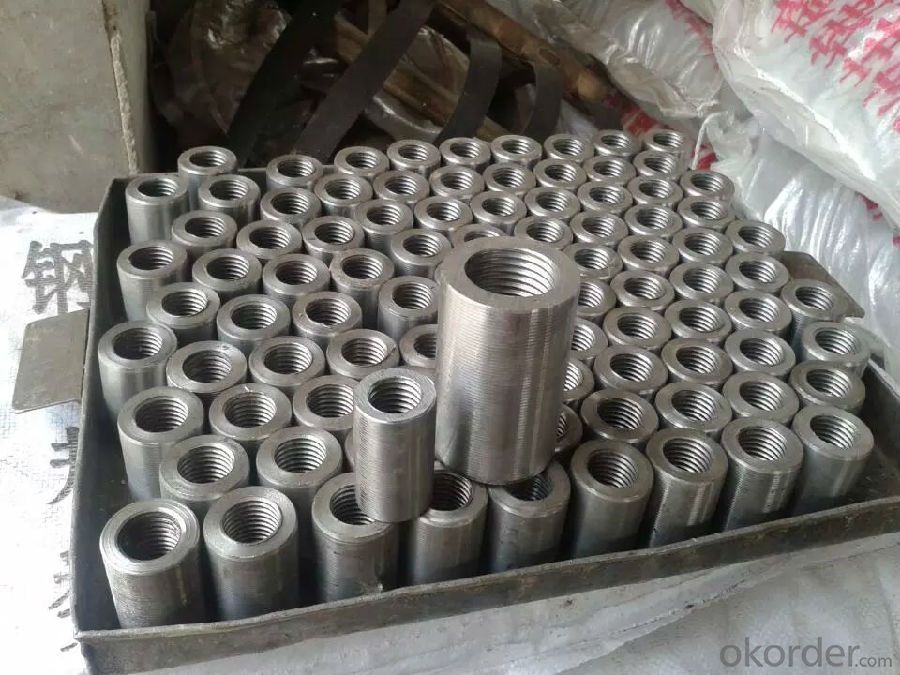

2.Advantages of Steel Coupler Rebar Lift Scaffolding Galvanized Scaffolding Tube with Low Price:
The coupler system provides the opportunity to connect rebars quickly, easily and cost effectively, even when large rebar diameters are used. This makes the steel coupler rebar range a logical extension to our rebendable CNBM reinforcement continuity system for rebars over 12 mm.
3.Available sizes of Steel Coupler Rebar Lift Scaffolding Galvanized Scaffolding Tube with Low Price:
14mm,16mm,18mm,20mm,22mmm,25mm,28mm,32mm,36mm,40mm
4.Delivery:
Delivery Term: FOB / CFR / CIF available.
Delivery Time: 15 days or less after order confirmed.
5.Why choose us?
Technical Expertise
Experienced Management
Stringent Quality Control
Exemplary Service
On-Time Delivery
Wide Product Range
Competitive Pricing
Huge branch network capable of catering worldwide
- Q: Can steel formwork be used for both small and large-scale construction projects?
- Indeed, steel formwork proves to be applicable for construction projects of both small and large scales. It presents numerous advantages, including durability, reusability, and flexibility. Its ability to endure immense pressure and loads renders it suitable for extensive projects necessitating substantial concrete pouring. Moreover, the modular nature of steel formwork permits effortless customization and adaptation to diverse project sizes and designs. This characteristic renders it equally fit for smaller construction projects that require a swift and effective formwork system. Additionally, steel formwork guarantees a polished and superior finish to concrete structures, ensuring a uniform appearance irrespective of the project magnitude. All in all, steel formwork emerges as a versatile and dependable option for construction projects, be they small or large in scale.
- Q: Can steel formwork be used in areas with limited construction access roads?
- Yes, steel formwork can be used in areas with limited construction access roads. Unlike traditional formwork made of wood or other materials, steel formwork is durable, lightweight, and can be easily transported to remote locations. It can be disassembled and reassembled multiple times, making it suitable for areas with limited access roads where transportation of heavy construction materials is challenging. Additionally, steel formwork offers high strength and stability, ensuring the structural integrity of the construction even in difficult-to-reach areas.
- Q: What are the different safety training requirements for steel formwork installation?
- The safety training requirements for steel formwork installation may vary depending on the specific regulations and guidelines set by different countries and organizations. However, here are some common safety training requirements that are typically applicable: 1. General Construction Safety Training: All workers involved in steel formwork installation should undergo general construction safety training. This training usually covers topics such as hazard recognition, proper use of personal protective equipment (PPE), fall protection, and proper lifting techniques. 2. Steel Formwork Specific Training: Workers should receive specialized training on the specific techniques and procedures related to steel formwork installation. This training may include topics such as proper assembly and dismantling techniques, securing formwork to prevent collapse, and ensuring stability during concrete pouring. 3. Equipment Training: Workers should be trained on the safe operation of any equipment used during steel formwork installation. This may include training on the safe use of cranes, forklifts, or any other machinery involved in the process. 4. Hazard Communication: Workers should receive training on hazard communication, including understanding safety signs and labels, handling hazardous materials, and knowing how to respond to emergency situations. 5. First Aid and CPR Training: It is important for workers to be trained in first aid and CPR techniques to be prepared for any potential accidents or injuries that may occur during steel formwork installation. 6. Scaffold Safety Training: If scaffolding is used during the installation process, workers should undergo scaffold safety training to ensure they understand how to assemble, use, and dismantle scaffolding safely. 7. Job-Specific Safety Training: Depending on the specific tasks involved in steel formwork installation, workers may need additional job-specific safety training. This could include training on working at heights, working with power tools, or working in confined spaces. It is essential for employers and workers to follow the applicable safety regulations and ensure that all necessary training is provided to create a safe working environment during steel formwork installation.
- Q: What are the different types of formwork connectors used in steel formwork?
- There are several types of formwork connectors that are commonly used in steel formwork systems. These connectors play a crucial role in ensuring the stability and strength of the formwork structure. Some of the different types of formwork connectors used in steel formwork include: 1. Wedge Lock Connector: This type of connector is widely used in steel formwork systems. It consists of two separate pieces – a wedge and a lock. The wedge is inserted into the formwork joint, and the lock is then inserted to secure the wedge in place. This connector provides a tight and secure connection, which helps in maintaining the formwork's stability. 2. Pin and Wedge Connector: This connector comprises a pin and a wedge. The pin is inserted through the holes in the formwork panels, and the wedge is then driven into the hole, securing the pin in place. The pin and wedge connector is easy to install and provides a strong connection between the formwork panels. 3. Rapid Clamp Connector: This type of connector is designed to quickly and securely connect steel formwork panels. It consists of a clamp that is tightened around the formwork panel, providing a reliable and sturdy connection. The rapid clamp connector is often used in applications where a quick assembly and disassembly of formwork is required. 4. Hook and Loop Connector: This connector utilizes a hook and loop fastening system to connect the formwork panels. The hook and loop strips are attached to the edges of the formwork panels, allowing them to be easily and firmly connected. This type of connector is commonly used in applications where frequent adjustments or reconfigurations of the formwork are needed. 5. Magnetic Connector: This connector uses magnets to securely connect the steel formwork panels. The magnets are embedded within the formwork panels, allowing them to easily snap together. The magnetic connector is known for its quick installation and disassembly, making it ideal for projects with tight schedules. These are just a few examples of the different types of formwork connectors used in steel formwork. Each connector has its own unique features and benefits, and the selection of the appropriate connector depends on the specific requirements of the project and the formwork system being used.
- Q: Can steel formwork be used for both straight and curved concrete walls?
- Certainly, both straight and curved concrete walls can be constructed using steel formwork. The versatility of steel formwork lies in its ability to be effortlessly bent and adjusted, enabling the creation of curved walls in diverse sizes and shapes. By providing robust support and stability, it ensures the construction of both straight and curved walls with utmost precision and accuracy. Moreover, steel formwork's durability and reusability render it a cost-effective choice for projects necessitating both straight and curved concrete walls.
- Q: How does steel formwork handle different concrete surface repair techniques?
- Steel formwork is a versatile and durable option for handling different concrete surface repair techniques. One of the key advantages of steel formwork is its ability to withstand the pressures and stresses associated with concrete repairs. When it comes to techniques such as patching or resurfacing, steel formwork provides a strong and stable framework to contain the concrete mixture. It can withstand the weight of the repair materials and the pressure exerted by the concrete as it sets and cures. This ensures that the repair is properly contained and that the desired shape and dimensions are achieved. Steel formwork also offers flexibility in terms of shape and design. It can be easily customized to accommodate different repair requirements, whether it involves straight surfaces, curves, or complex geometries. The strength of steel allows for the creation of intricate formwork structures that can handle even the most challenging repair projects. Moreover, steel formwork provides excellent reusability and durability. It can be used repeatedly without significant wear and tear, making it a cost-effective solution for multiple repair projects. This durability ensures that the formwork remains intact throughout the repair process, maintaining the integrity of the repair and preventing any potential issues. Furthermore, steel formwork is resistant to moisture and chemicals, which are often present in concrete repairs. This resistance ensures that the formwork remains in good condition and does not corrode or deteriorate when in contact with the repair materials. This is particularly important for long-term repairs where the formwork may be in place for an extended period. In conclusion, steel formwork is a reliable and effective option for handling different concrete surface repair techniques. Its strength, flexibility, reusability, and resistance to moisture and chemicals make it an ideal choice for containing and shaping the repair materials, ensuring a successful and durable repair.
- Q: What are the different types of bracing used with steel formwork?
- There are several types of bracing used with steel formwork, each serving a specific purpose in ensuring the stability and strength of the structure being formed. 1. Diagonal Bracing: This type of bracing is used to provide stability and prevent lateral movement of the formwork. Diagonal braces are typically installed at an angle between two corners of the formwork, forming an "X" shape. They help distribute the loads evenly and resist the forces acting on the structure. 2. Vertical Bracing: Vertical braces are used to support the formwork vertically and prevent any sagging or bulging. They are typically installed along the height of the formwork at regular intervals, providing additional support and rigidity to the structure. 3. Horizontal Bracing: Horizontal braces are used to resist the horizontal forces acting on the formwork. They are installed horizontally, typically at the top and bottom of the formwork or at specific intervals along the length, providing stability and preventing any deformation caused by external loads. 4. Tension Rod Bracing: Tension rods are used to distribute the loads and provide additional reinforcement to the formwork. They are usually installed diagonally or horizontally, depending on the specific requirements of the structure. Tension rod bracing is particularly effective in resisting excessive deflection and preventing the formwork from collapsing under heavy loads. 5. External Bracing: External bracing is used when additional support is required, especially in cases where the formwork is exposed to high wind loads or other external forces. These braces are typically installed on the outer side of the formwork and are designed to provide extra stability and prevent any deformations caused by external factors. 6. Tie Rods: Tie rods are used to hold the formwork together and provide uniform pressure on the structure. They are usually installed horizontally or vertically and are tightened with nuts to secure the formwork in place. Tie rods also help distribute the loads evenly across the formwork, preventing any bulging or deformation. Overall, the different types of bracing used with steel formwork play a crucial role in ensuring the stability, strength, and integrity of the structure being formed. They work together to resist external forces, distribute loads evenly, and prevent any deformations or failures during the construction process.
- Q: How does steel formwork handle formwork alignment and leveling?
- Steel formwork is a highly efficient and versatile system that excels in handling formwork alignment and leveling. It offers several features and mechanisms that ensure precise and accurate formwork placement. Firstly, steel formwork is known for its robustness and rigidity, which allows it to maintain its shape and dimensions during the pouring and curing of concrete. This inherent stability ensures that the formwork remains aligned and level throughout the construction process. In addition, steel formwork often incorporates adjustable components such as screws, wedges, and clamps. These elements enable fine-tuning of the formwork's position and elevation, allowing for precise alignment and leveling. By simply adjusting these components, workers can easily correct any deviations and ensure that the formwork is perfectly aligned. Furthermore, steel formwork systems often utilize integrated leveling systems. These systems typically consist of hydraulic jacks or mechanical devices that provide controlled and precise leveling. By utilizing these mechanisms, workers can easily adjust the formwork's height and maintain a consistent level across the entire structure. Moreover, steel formwork is capable of withstanding significant loads and pressures exerted by the concrete during pouring. This strength allows it to resist any deformation or deflection, ensuring that the formwork remains aligned and level even under challenging conditions. Overall, steel formwork offers exceptional capabilities in handling formwork alignment and leveling. Its inherent stability, adjustable components, integrated leveling systems, and strength make it a reliable choice for maintaining the desired accuracy and precision during concrete construction projects.
- Q: Can steel formwork be used for both regular and irregular concrete structures?
- Yes, steel formwork can be used for both regular and irregular concrete structures. Steel formwork is highly versatile and can be easily customized to fit any shape or size of the structure. This makes it suitable for constructing both regular structures with standard dimensions as well as irregular structures with unique shapes and designs. The flexibility of steel formwork allows for efficient construction of various types of concrete structures, including walls, columns, beams, slabs, and even complex architectural features. Additionally, steel formwork offers high strength and durability, ensuring that it can withstand the pressure and weight of the concrete during the pouring and curing process, regardless of the structure's regular or irregular shape. Overall, steel formwork is a reliable and adaptable choice for constructing both regular and irregular concrete structures.
- Q: What are the common safety precautions when working with steel formwork in extreme temperatures?
- When working with steel formwork in extreme temperatures, it becomes imperative to implement specific safety measures in order to safeguard the workers' well-being and successfully complete the project. Consider the following essential safety precautions: 1. Adequate Personal Protective Equipment (PPE): Workers must wear suitable PPE, including heat-resistant attire, gloves, and safety goggles, to shield themselves from extreme temperatures and potential hazards. 2. Regular hydration: It is crucial to ensure that workers stay hydrated when faced with extreme temperatures. Encourage frequent breaks for water consumption and provide access to cool drinking water on-site. 3. Provision of shaded and rest areas: Establish shaded spaces or rest zones where workers can take breaks and escape direct exposure to heat. This will help prevent heat-related illnesses such as heat exhaustion or heat stroke. 4. Training and awareness: Guarantee that all workers receive proper training and education regarding the potential risks associated with working in extreme temperatures. They should be knowledgeable about the signs of heat-related illnesses and be prepared to respond in emergency situations. 5. Monitoring weather conditions: Regularly check weather forecasts and stay informed about extreme temperature warnings or heat advisories. If possible, adjust work schedules to minimize exposure to extreme heat. 6. Implementation of a buddy system: Establish a buddy system where workers can watch out for each other. This ensures that any heat-related issues can be promptly identified and addressed. 7. Regular breaks and scheduling: Plan work schedules in a manner that allows for frequent breaks and rest periods. This helps prevent overexertion and reduces the risk of heat-related illnesses. 8. Proper ventilation: Ensure that the work area is adequately ventilated to facilitate air circulation and minimize heat accumulation. This can be achieved through the use of fans or natural ventilation methods. 9. Regular communication: Maintain open lines of communication with workers to monitor their well-being and address any concerns they may have regarding working in extreme temperatures. 10. Emergency response: Establish a well-defined emergency response plan that includes procedures for handling heat-related emergencies. This should encompass providing first aid, accessing medical assistance, and evacuating the work area if necessary. By adhering to these common safety precautions, workers can mitigate the risks associated with working in extreme temperatures while utilizing steel formwork, thereby ensuring a safe and productive work environment.
Send your message to us
Steel Coupler Rebar Scaffolding Truss Aluminum Scaffolding Beam Low Price
- Loading Port:
- Shanghai
- Payment Terms:
- TT OR LC
- Min Order Qty:
- 10000 pc
- Supply Capability:
- 10000000 pc/month
OKorder Service Pledge
OKorder Financial Service
Similar products
Hot products
Hot Searches













